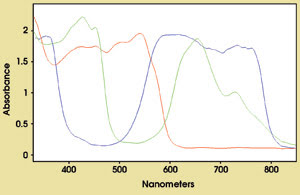Michael De Jonge, Prior Scientific, and Dr. Paul Martin, Craic Technologies
The number of manufacturing applications where spectral analysis of minute samples or areas is required is on the rise. To meet the demands of high throughput and precision, many companies, educational institutions and government agencies are combining automated positioning and UV/VIS/NIR microspectrophotometry.
Microspectrophotometry can be described as a refinement of UV/VIS/NIR spectrophotometry. Put simply, it combines the image magnification of a microscope with the intensity vs. wavelength measurement capabilities of a spectrophotometer. These systems are used for a variety of leading-edge manufacturing applications, such as in the automotive industry, where they are used for development and quality control of paints, and in the ink and toner industry, where they are used to test and monitor quality control of pigment particles.
Craic Technologies has developed microscope optics to illuminate and image a sample with light that spans the range from the deep-UV to the near-IR. The microscope focuses the light onto the first of three apertures of an integrated spectrophotometer, which measures the intensity of light at each wavelength, resulting in absorbance, reflectance or even fluorescence spectra from sampling areas as small 1 μm. This technique is increasing in popularity, not only because it requires only trace amounts of sample, but also because it is a noncontact, nondestructive testing method that allows the same instrument to be used for a number of spectral investigative techniques.
Too thick or too thin
Take, for example, the semiconductor industry, where quality control of film thickness must be carried out using several very small areas of a sample. The company recently developed a UV/VIS/NIR microspectrophotometry system that scans wafers to measure film thickness using both reflectance and transmittance properties. The QDI 1000-S is an automatic system that scans the surface of a wafer sample at predetermined points to measure the film thickness. The microspectrophotometer, which is driven by instrument control/data analysis software, is coupled with a PCI high-speed controller card and an X-Y motorized stage, both manufactured by Prior Scientific. The software driving the stage is integrated with the microspectrophotometer controller software to allow complete automation and ease of use.
To operate the system, the user starts the program, and the automatic stage positions the wafer and captures each designated measurement without the need for further human intervention. The stage can be programmed by the operator to take measurements at an unlimited number of locations. This system can measure more than 100 selected points in less than two minutes. The microspectrophotometer analyzes the interference pattern at each location to determine the thickness of the films deposited at that point.
Defect detection
Flat panel display manufacturers also use microspectrophotometers to measure variations within individual pixels in color masks and to monitor the variability of the color of light emitted from the illumination sources for the displays. These screens are inspected and measured not only to ensure quality control in manufacturing, but also for new-product development. The inspection process ranges from monitoring the spectral characteristics of the individual red, green and blue pixels of the color mask to analyzing the variability of the light source across the surface of the screen.
In this application, the user places the flat panel displays in the system and programs the points to be visited. The system automatically takes the measurements, not only achieving higher throughput, but also offering ease of use and improved ergonomics. It also provides the capability to program patterns. The resulting higher efficiency and repeatability enables more precise measurement of all three dimensions than is possible with a conventional manual stage and focus mechanism.

The automated microspectrophotometer enables the rapid and precise analysis of the absorbance spectra of red, green and blue pixels on an LCD color mask from a flat panel display. By comparing spectra from different pixels, researchers can see whether the dye and its concentration are consistent or whether they monitor individual pixels for continuity of color.
Having the ability to go back to the exact location (in terms of the X-, Y- and Z-coordinates) on the sample and obtain another spectrum is extremely valuable to an engineer or technician attempting to determine the source of a flaw in the process. The combination of automated positioning and UV/VIS/NIR microspectrophotometry creates a tool that shows great promise in the manufacture of photonic components.
These are just some of the many applications of a UV/VIS/NIR microspectrophotometer with automated sampling. These tools can measure spectra of microscopic sampling areas by transmitted and reflected light.
Microspectrophotometers with automated positioning also can measure fluorescence emission with the same instrument, making them useful for contaminant detection in the semiconductor process line or in biological screening for medical research or national defense.
Meet the authors
Michael De Jonge is western regional sales manager at Prior Scientific in Rockland, Mass.; e-mail: [email protected].
Paul Martin is president of Craic Technologies in Altadena, Calif.; e-mail: [email protected].